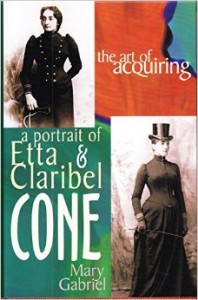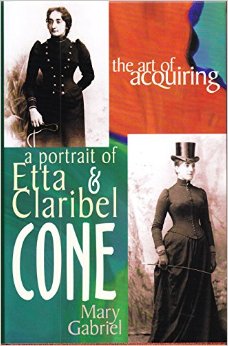 The Art of Acquiring: A Portrait of Etta & Claribel Cone
The Art of Acquiring: A Portrait of Etta & Claribel Cone
by Mary Gabriel
Bancroft Press. 256 pages, $35.
OF THE MANY women who figured in the lives of Gertrude Stein and her circle in the early 20th century, the Cone sisters—fabulously wealthy, single women from Baltimore—stand out as power brokers in the Paris art world in their own right. Their money came from the family’s denim mills, the largest in the world. Although deeply steeped in the Victorian mores of their time, they bought “works by artists who, at the time, were dismissed as charlatans, or denounced as pornographers, and sometimes both,” in the words of Mary Gabriel in The Art of Acquiring. Among these artists were Matisse, Picasso, Rodin, Dégas, and van Gogh.
Claribel Cone graduated from the Women’s Medical College of Baltimore, but only practiced for a short time before moving back home, where she often held evening salons. When Gertrude Stein moved to Baltimore as a teenager, she met the Cones, who possibly were distant relatives, and her role model became Dr. Claribel (it will be recalled that Gertrude went on to attend Johns Hopkins Medical School). Etta, who often appeared to be in Claribel’s shadow both physically and intellectually, took Leo Stein as her role model, and for a time she certainly appeared to have had a crush on him. Constantly traveling, the sisters often lived in Europe for long periods, and Claribel sat out much of the First World War in Munich—because, she said, it was too inconvenient to leave. Gabriel stated: “For Claribel, other people were of value only if they could be useful to her or if they could appreciate her genius,” and she did not feel the need to share the world or her experiences with anyone. But she did accede to a request for physicians to help treat the wounded in post-war Munich street battles.
The sisters’ sexual orientation—if indeed they were aware they could have such an orientation!—has always been a matter for speculation. Gabriel quotes an article from Art News in 1980 in which Etta wrote to a niece, observing that “people believed there was ‘something between Gertrude and Alice,’ but [Etta] did not think so. ‘After all,’ she asked, ‘what can two women do?’” It is unclear to scholars whether Etta figured as a character in Stein’s Q.E.D., (published posthumously in 1950) about a romantic triangle on a transatlantic voyage in 1901. Etta became Gertrude’s secretary—before Alice B. Toklas entered the scene—and typed the manuscript of Three Lives (1909). Alice “made no secret of her dislike for any woman who might have been intimate with Gertrude prior to her arrival on the scene.” In 1912, Gertrude Stein wrote a “word portrait” of the sisters, Two Women, in which she called them Martha and Ada.
In 1957, the Baltimore Museum of Art opened the Cone Wing, but even with expansion in more recent years, only 120 works out of their collection of 3,000 items, now worth about one billion dollars, can be displayed at any one time. (The website irc.umbc.edu/masterframe provides a virtual tour of the Cone sisters’ home and some of the works they acquired.)
Complete with lovely, if too few, reproductions of art from their collection, The Art of Acquiring is an engrossing book and a well-conceived synthesis of world history, art history, and biography. Though the Cone sisters fell out with Gertrude Stein in later years, this portrait of their early years together sheds new light on the endlessly fascinating Stein circle. As for the sisters themselves, it seems that they existed in a kind of love-hate relationship for much of their lives.






